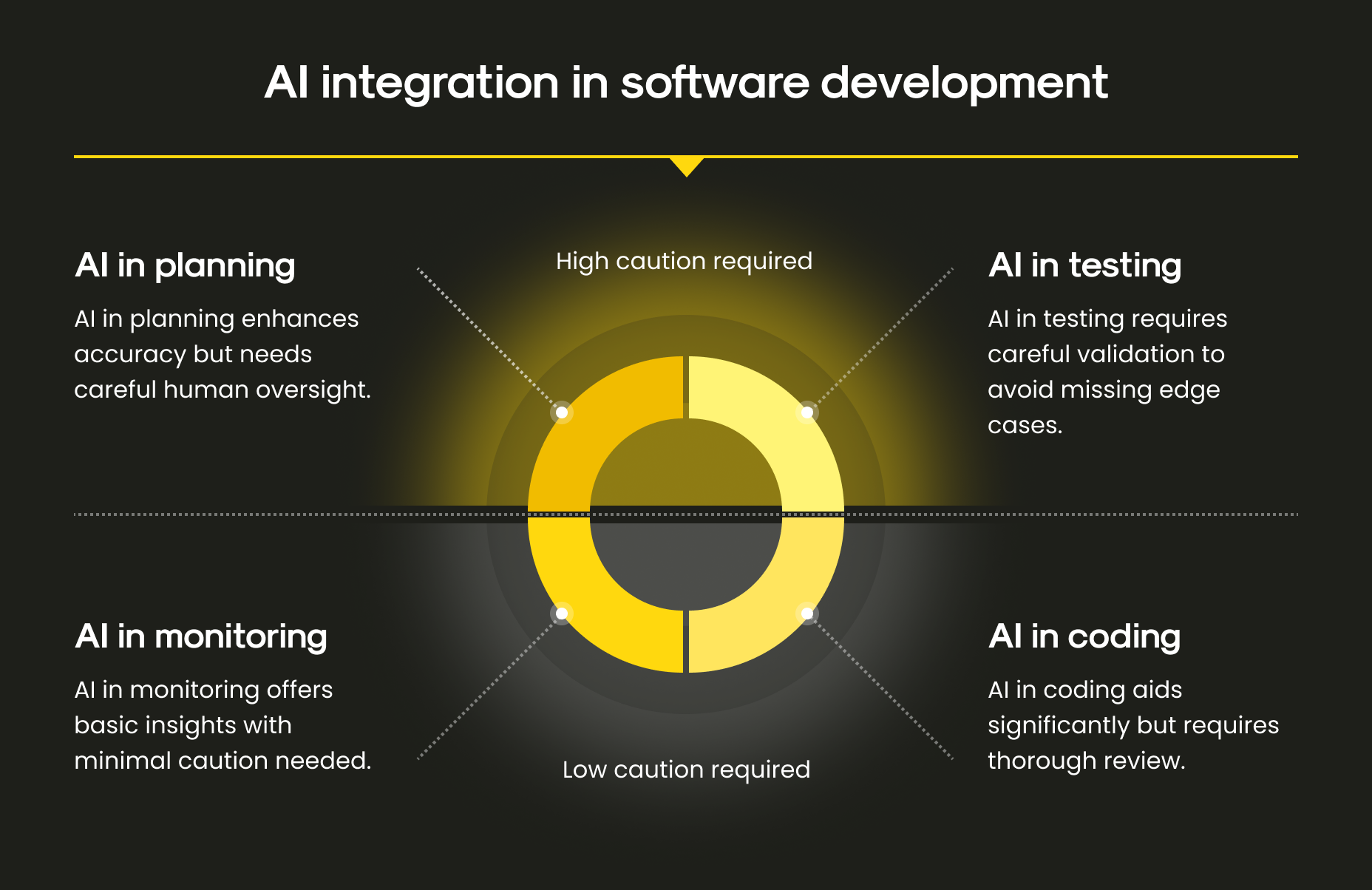Artificial intelligence in software development is a shift in how we build, test, and maintain digital systems. Machine learning models embedded in product features, automated test case generation using AI, AI copilots helping developers write code, you name it. In other words, artificial intelligence is fundamentally changing what it means to be a tech team.
However, the human factor still matters. The teams building AI-enabled systems must evolve their skills, workflows, and mindset. What’s more, the workflow requires more than a crash course in Python or TensorFlow. It calls for a structured approach to training, culture-building, and long-term readiness. In this article, you’ll discover:
- Why AI is redefining the way software teams build, test, and ship digital products
- How to assess your team’s readiness across AI, data, and DevOps capabilities
- Why collaboration skills like prompt writing and model evaluation are critical for engineers
- How to embed ethical thinking, risk awareness, and governance into AI training
- How to create a culture that rewards experimentation, learning, and cross-functional teamwork
- The importance of assigning clear AI ownership and creating real growth pathways
- How Mitrix helps companies build smarter products with custom AI copilots, RAG systems, private LLMs, and more
Step 1. Assess your team’s AI readiness
Before you roll out any training programs, take a hard look at your current capabilities. AI development spans multiple domains: data engineering, MLOps, cloud architecture, and domain-specific problem-solving. Ask:
- Who understands the basics of AI/ML?
- Who has experience working with data pipelines?
- Do you have expertise in model evaluation, tuning, or interpretability?
- Is your DevOps team familiar with model deployment and monitoring?
This assessment doesn’t just help you identify gaps, it helps you avoid wasting time training the wrong people in the wrong skills. For instance, a front-end engineer doesn’t need to become a data scientist overnight. However, they do need to understand how AI components affect the interfaces they build.
Step 2. Build a foundational curriculum
Once you understand where you stand, develop a shared baseline of AI knowledge across the team. This certainly doesn’t mean everyone needs a PhD in neural networks, but everyone should understand:
- What AI/ML is (and isn’t)
- The basics of training vs. inference
- Data quality and bias issues
- The lifecycle of an AI system
- The limitations and risks of generative AI
Many organizations rely on internal workshops or partner with online learning platforms like Coursera, DeepLearning.AI, or fast.ai. Consider making the following levels:
Level 1. AI literacy (all roles)
Non-technical overviews, case studies, and real-world examples of AI in software products.
Level 2. Technical foundations (developers and data engineers)
Intro to machine learning, basic model training, common libraries (scikit-learn, PyTorch, Hugging Face), and simple project work.
Level 3. Advanced topics (AI leads, architects)
Model interpretability, fine-tuning, retrieval-augmented generation (RAG), prompt engineering, and deployment best practices.
Pro tip: Encourage hands-on experimentation and let your team tinker with APIs like OpenAI, Claude, Gemini, or open-source models. The thing is, theory without context tends to fade quickly.
Step 3. Train on AI collaboration, not just development
Many teams make the mistake of thinking AI training ends at learning how to build models. But in reality, most engineers will be consuming AI systems and not creating them from scratch.
This means your team should learn:
- How to integrate AI APIs safely and responsibly
- How to evaluate model output (hallucinations, bias, reliability)
- How to collaborate with data scientists or AI specialists
- How to write prompts that get useful responses from LLMs
- How to debug “black-box” outputs using logs, test inputs, and evaluation tools
The main thing to understand is that AI is a collaborator, not just a component. Training your team to think critically and communicate well around AI output is just as important as knowing how the algorithms work.
Step 4. Build ethical awareness and risk management skills
Let’s face it: AI can go sideways fast. From unintentional bias in recommendations to data leakage, companies that rush AI into production often find themselves in trouble later. This way, it makes perfect sense to prepare your team by embedding ethical thinking and risk mitigation into your training plan:
- Bias detection. Teach developers how models can reinforce unfair patterns and how to test for bias.
- Privacy awareness. Make sure your team understands the difference between anonymized and truly private data.
- Security risks. Cover prompt injection, model poisoning, and other emerging threats.
- Governance models. Show how to document decisions, create audit trails, and justify AI outputs to stakeholders.
Luckily, you don’t need a legal department to do this well, just a strong culture of responsibility and shared standards.
Step 5. Practice real-world AI DevOps
AI doesn’t stop at training a model. Your team needs to treat AI systems like living, breathing components that change over time. This means building fluency in MLOps – the AI version of DevOps. Key practices include:
- Model versioning. Tracking changes to models and understanding the impact on performance.
- Performance monitoring. Watching for data drift, accuracy drops, or unfair outcomes in production.
- Retraining workflows. Setting up pipelines for continuous learning or model fine-tuning.
- Shadow mode testing. Running models in parallel before turning them fully live.
These skills often live at the intersection of data engineering, cloud infrastructure, and software QA, so cross-functional collaboration is essential.
Step 6. Foster an AI-ready culture
Technology training won’t stick if your company culture punishes curiosity or demands perfection on day one. AI-enabled development requires experimentation, iteration, and a tolerance for ambiguity.
To foster an AI-ready culture:
- Celebrate small wins. Let developers showcase prototypes, even if they don’t make it to production.
- Create internal AI Guilds or Slack channels for knowledge-sharing.
- Encourage “prompt labs” or hack days where teams experiment with LLMs or data agents.
- Make failure safe. Share lessons from misfires as much as success stories.
Most importantly, normalize the idea that nobody has all the answers yet. The AI landscape evolves weekly, but your team’s job isn’t to master it all; it’s to stay adaptable.
Step 7. Assign ownership and pathways
Finally, structure matters. If AI is “everyone’s job,” then it’s no one’s job. Assign clear ownership of AI enablement within your org. This might include:
- AI champions or tech leads who curate tools, standards, and documentation
- Cross-functional squads pairing product, engineering, and data experts
- Mentorship tracks for developers who want to specialize in AI/ML
And don’t forget to connect AI skills to real career growth. Internal certifications, role transitions, and public recognition can go a long way in motivating participation.
Key takeaway
To upskill your team for AI-enabled development, start by assessing existing capabilities across data, DevOps, and AI to identify gaps and training priorities. Build a shared foundation with tiered learning paths, ensuring everyone understands how to work alongside AI, not just build it. Focus training on collaboration skills like prompt writing, API integration, and ethical awareness, especially around bias, privacy, and security.
 AI integration in software development
AI integration in software development
Integrate MLOps into the mix so teams can manage models post-deployment just like traditional code. Foster a culture where experimentation is encouraged, failures are learning opportunities, and internal communities support ongoing growth. Finally, assign clear roles and ownership to embed AI readiness into your org’s DNA and make continuous learning part of how you ship smarter, faster software.
How Mitrix can help
Here at Mitrix, we’ll help you turn smart ideas into smarter products. Whether it’s automating workflows or building next-gen products with generative tech, we’ve got you covered. We offer AI/ML and generative AI development services to help businesses move faster, work smarter, and deliver more value.
Custom AI copilot development
- Tailored AI assistants for specific business operations (e.g., finance, legal, HR)
- Integration with internal tools (Slack, Microsoft 365, CRMs)
- Context-aware and role-specific assistants
RAG (Retrieval-Augmented Generation) systems
- Building LLM apps that combine real-time data search with AI response
- Often used in customer support, internal knowledge bases, and legal tech
Private LLM deployment
- On-premise or private cloud deployment of open-source models (e.g., LLaMA, Mistral, DeepSeek)
- Security- and compliance-focused use cases (e.g., in healthcare, finance, or legal)
Finetuning & customization
- Fine-tuning open-source models on proprietary data
- LoRA, QLoRA, and full finetuning of LLMs
- Domain-specific model training and quantization (e.g., legal, finance, medical)
AI integration for legacy systems
- Connecting LLMs to ERP/CRM/accounting systems (e.g., SAP, Dynamics GP, Salesforce)
- Creating natural language interfaces for complex backend systems
AI chatbots and virtual agents
- Advanced AI-powered customer service bots
- Multilingual support, emotion detection, dynamic memory
- Used in retail, banking, and healthcare
Voice AI & speech-to-text solutions
- AI transcribers and voice assistants for customer support or medical dictation
- Custom Whisper-based or Speech-to-Text integrations
Computer vision
- Solutions for real-time detection and segmentation for images and video
- Optimization for edge devices and IoT deployment
- Generative models for image content creation and integration with AI agents
Our engineers bring expertise across industries and technologies to design, build, and integrate intelligent systems that fit your exact needs with measurable impact. Contact us today!
Wrapping up
AI is reshaping how software gets built: accelerating delivery, reducing friction, and unlocking entirely new ways to innovate. But success doesn’t happen by accident. It starts with upskilling your team, fostering a mindset open to change, choosing tools that align with your workflows, and thinking beyond quick wins. With thoughtful preparation, your developers won’t just adapt to AI; they’ll help define its next chapter.
The companies that thrive in this new era won’t just buy better tools, they’ll build better teams. Teams that know how to evaluate AI, use it responsibly, and collaborate across disciplines. So don’t wait for the perfect strategy or the next must-have AI model. Start small, train often, and build a team that’s ready to learn, adapt, and lead. The reason is simple: the future of development is collaboration between humans and intelligent systems.


